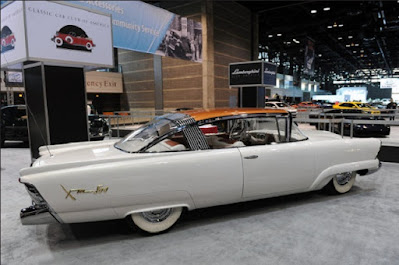We're sorry, If you are looking for 'Il Mostro,' jump here.
⛔ Hidden GEMS 💣 - The following article is about Mercury, a brand of mid-priced automobiles produced by American manufacturer Ford Motor Company from 1938 to 2011, was created by Edsel Ford in 1938 to bridge the gap between Ford and Lincoln model lines. Its main competitors were Buick and Oldsmobile from General Motors, as well as DeSoto and Chrysler from Chrysler Corporation.
 |
| The 1956 Mercury XM Turnpike Cruiser, constructed by Ghia at a cost of $80,000, significantly influenced and propelled the styling of the all-new 1957 Mercury line. (Picture from: Carscoops) |
 |
| The 1956 Mercury XM Turnpike Cruiser show car while sat on display at the 1956 Cleveland Auto Show. (Picture from: Motorcities.org) |
Led by John Najjar, the Ford Motor Company design team initially named the concept car the Mandalay in 1954. Jack Reith, a Ford executive, recognized its potential and advocated for further development. The team, including Elwood Engel, Gene Bordinat, Don DeLaRossa, and Larry Shinoda, joined to refine the design.
 |
| The front end of the 1956 Mercury XM Turnpike Cruiser featured a sculpted grille with twin jet pods and included attractive transparent roof panels that could be raised or lowered for both drivers and passengers. (Picture from: Carscoops) |
Crafted by Ghia of Italy at a significant cost of $80,000, the 1956 Mercury XM Turnpike Cruiser became a symbol of show car styling that influenced the all-new 1957 Mercury line. Despite Ford Motor Company's vision of it as an experimental car anticipating future automotive needs, the 1957 Mercury faced challenges in the market.
 |
| The 1956 Mercury XM Turnpike Cruiser' cabin boasted four bucket seats with two-tone leather upholstery. (Picture from: Carscoops) |
The 1956 Mercury XM-Turnpike Cruiser featured a unique transparent roof panel and a plastic "butterfly" top, offering a blend of futuristic design elements. Its front end showcased a sculpted grille with twin jet pods and V-shaped taillights, alluding to its innovative styling direction.
 |
| The 1956 Mercury XM Turnpike Cruiser powered bya a 312 CID Y Block V8 engine and Merc-O-Matic transmission. (Picture from: Carscoops) |
Inside, the show car boasted four bucket seats with two-tone leather upholstery, powered by a 312 CID Y Block V8 engine and Merc-O-Matic transmission. Its debut at the 1956 Chicago Auto Show marked it as a "preview of the future."
 |
| The 1956 Mercury XM Turnpike Cruiser's rear-end adorned with a unique V-shaped taillights, alluding to its innovative styling direction. (Picture from: Carscoops) |
Over the years, the show car endured storage and damage until restoration enthusiast Tom Maruska acquired it in 2017, investing significantly to restore it to its original condition. Maruska's dedication reflects the enduring appreciation for automotive design history.
 In essence, the 1956 Mercury XM Turnpike Cruiser remains a pivotal chapter in automotive design, embodying innovation and timeless styling that continues to inspire admiration among enthusiasts and historians alike. *** [EKA [09112020] | FROM VARIOUS SOURCES | CARSTYLING.RU | CARSCOOPS | MOTORCITIES.ORG | KUSTOMRAMA ]
In essence, the 1956 Mercury XM Turnpike Cruiser remains a pivotal chapter in automotive design, embodying innovation and timeless styling that continues to inspire admiration among enthusiasts and historians alike. *** [EKA [09112020] | FROM VARIOUS SOURCES | CARSTYLING.RU | CARSCOOPS | MOTORCITIES.ORG | KUSTOMRAMA ]Note: This blog can be accessed via your smart phone













































